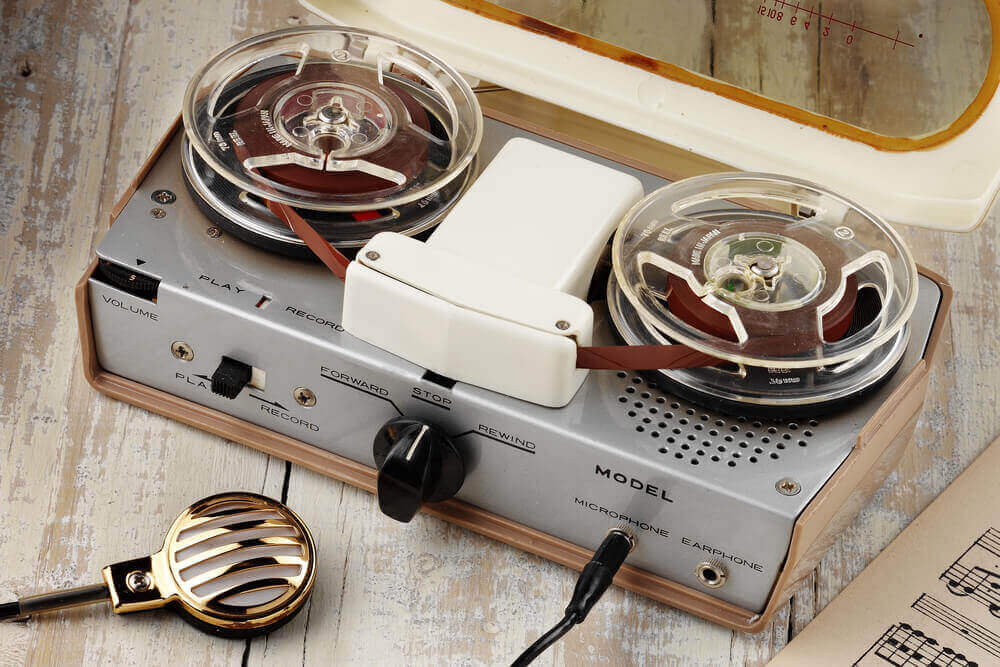Voice Recorder Invention: A Historical Overview

Contemporary voice recorders we hold in our hands or carry in our pockets have a long, illustrious developmental history. While taken for granted by most modern consumers, these innovative gadgets bear moot but powerful testimony to human persistence and brilliance.
Today’s portable handheld recording devices evolved over four distinct chronological stages. Each of which witnessed unique challenges and specific advances in audio recording technology. Keep reading about the evolution of portable voice recorders and how they influenced the history of voice recording equipment.
Acoustic Era – 1877 to 1925
This phase of voice recording history marked the earliest sound recording and duplication methods. All of which were completely mechanical. Speakers voices were captured by a thin membrane called a diaphragm. This component was attached to a needle that reproduced sound by cutting a spiral groove into the surface of the diaphragm. The phonograph and gramophone were the two most common types of acoustical voice recorders.
The first known tape recorder was invented at Alexander Graham Bell’s private laboratory. Patented in 1886, the mechanism integrated a thin strip of paper coated with paraffin and beeswax. One side was scraped clean while the opposite side was allowed to harden. This wax strip moved past a recording head or playback stylus located between two eight-inch reels. The entire assembly was housed in a sturdy wooden and metallic box that was powered by a knob attached to a flywheel. Despite never having been commercially developed, the machine became a key predecessor to portable magnetic voice recorders.
Electrical Era – 1925 to 1945
Overall quality of disc-based sound recording enhanced considerably during this phase. At the start of the Electrical Era, the gold standard for home audio recording systems was a specialized phonograph equipped with a spring-wound acoustical device that utilized waveguide technology and a creased horn to produce a relatively flat frequency response. Electrical recording capability greatly enhanced reproduced audio quality and the flexibility of that process, largely by enabling microphones to capture audio.
Magnetic Era – 1945 to 1975
The scientific principles underlying the magnetic voice recording process had in fact been a demonstrated theory since 1898. That was the year when Valdemar Poulsen exhibited his now-famous telegraphone. Magnetic voice recorders integrated a magnetized medium that moved past a recording head at a constant rate of speed. An electrical signal akin to recorded sound is simultaneously conducted to the recording head, thereby activating a pattern of magnetization very similar to the signal. A playback head then detects changes in the magnetic field generated by the tape and converts it to an electrical signal.
Such magnetic wire recorders gave rise to magnetic tape recorders. First emerged in 1932 when the British Broadcasting Corporation utilized a steel tape recorder for its Christmas Day broadcast, magnetic tape voice recorders greatly improved sound quality. Indeed, the difference was so dramatic that many audience members who attended early magnetic tape recorder demonstrations couldn’t believe recorded performances were not live.
Digital Era – 1975 to The Present
The first practical digital voice recorders were reel-to-reel tape decks manufactured by Mitsubishi, Soundstream, Denon and a few competing firms. All early digital recorders integrated PCM recording technology. This technology utilized a combination of electrical signals and magnetic impulses to reproduce sound. However, less than half a decade later, most recording studios had upgraded to encrypted digitized audio content into a standardized video signal that was in turn captured by a videotape recorder with whatever rotating head protocol was the corresponding video standard.
A comparable digital voice recording process was developed for end users called Digital Audio Tape. Commonly abbreviated as “DAT,” this technology employed rotating heads attached to narrow tape contained within a compact cartridge called a cassette. DAT voice recorders operate at standard sampling rates of either 48 kHz or 44.1 kHz. The second value is the same as that used to record compact discs (CDs).
Digital Voice Recorders
HD recording gained popularity during the late 1990’s when HD capacities and CPU speeds rapidly increased. Digital audio files can be stored on all conventional PC media. The development of the MP3 audio file format has spurred most innovative musical distribution methods since the late 1990’s.
The emergence of electronic instruments has enabled automatic triggering of equipment during the recording process, with no direct human intervention. Likewise, the introduction of increasingly compact system components has facilitated the development of mini portable audio recorders. Such enhancements will undoubtedly continue to evolve as recorder technology advances.
